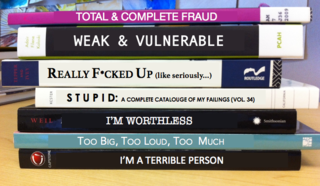Self-Esteem
"I’m Worthless" and Other Great Stories
Is low self-esteem holding you back?
Posted December 17, 2020 Reviewed by Matt Huston
We humans love a good story, so much so that we very easily blur the lines between fact and fiction. The infamous 1938 radio broadcast of H. G. Wells’ sci-fi book The War of the Worlds, produced by the up-and-coming star Orson Welles, is an excellent example of this. Welles created a hyper-realistic radio show about aliens from Mars invading New York state as a Halloween prank. Although reports of nationwide hysteria have been over-inflated, it is clear that many people were caught up in the radio broadcast and believed Martians had in fact begun their invasion.
Before you rush to dismiss this as the product of gullible old-timey folks, remember that there are at least three other documented cases of similar radio broadcasts creating similar, if not worse, chaos. It happened in Santiago in Chile in 1944. It happened again in Quito, Ecuador (with sadly disastrous consequences) and it happened again in the U.S., in Buffalo, New York in 1968. How could this keep happening?
What this phenomenon illustrates is that it is incredibly easy for us humans to be sucked in by good stories. We can’t help but get swept up in the drama and pulled along in the narrative. And there is one particular drama with a certain main character that we are all especially susceptible to getting caught up in—and that is of course the one about ourselves.

The stories we tell about ourselves—our self-stories—are the collections of memories, experiences, beliefs, and ideas about ourselves. A self-story helps us know who we are, what we are about and what kind of person we are. I like the term self-story because it reminds us that our sense of who we are is a narrative told over many years, it has many chapters to it; and while it is undoubtedly a work of non-fiction, it can at times tip into creatively told facts.
We often like to think of who we are as very stable and consistent, but it doesn’t take much to show how changeable our sense of self actually is. Imagine if you were to describe yourself across these situations:
- At a big job interview
- On a lazy Sunday
- On a first date
- When someone has cut in front of you when driving
- After hearing someone close to you has died
It would be reasonable to assume that “you” would change quite a lot between these different scenarios, which is entirely normal. A healthy self-story is one that is flexible and allows us to move between the different parts of our life with agility. It allows us to be strong when we need to be. It lets us be spontaneous when we want to be. And it allows us to be vulnerable when we need to be. It allows us to know important things about ourselves but also hold these facts lightly.
An unhealthy self-story is one that is very rigid and doesn’t allow much flexibility. It doesn’t recognize the limits and makes broad sweeping generalizations that cut across all situations. In this way, it helps to simplify things and remove lots of ambiguity. A self-story such as “I’m worthless,” on the face of it, sounds horrendous. But if it helps me avoid potentially painful situations ("I could never achieve what I want, so I’ll just stay on the couch"), or clarify uncertain situations (“He wouldn’t want to go out with someone like me anyway”), you can start to see the appeal.
Unhealthy self-stories have been around for a long time, and most likely rose up to help us cope with difficult circumstances growing up. But this often means they are extremely well-rehearsed, so we don’t even notice they are there.
What then can you do about your self-story? There are three key things that I use personally and recommend to just about everyone who comes to see me for therapy:
1. Find a way to learn how your past has affected you and continues to affect you today. Learn to see how this influenced the story you tell yourself about who you are and work to hold this story lightly. Therapy is one way to do this, but reading good books or talking with understanding friends also helps. Without a clear understanding of how your self-esteem monster operates, it can be tricky to make lasting changes.
2. Develop practical strategies to work with your self-story. Notice the patterns as it emerges. See how it wants to treat you and your most vulnerable feelings. Observe how it wants to hold you back from being the kind of person you want to be. Create space in your day to slow down. Practicing mindfulness is one way, but there are many methods to cultivate a space to accept your experiences without judgement.
3. Learn how to listen carefully and deeply to what really matters to you in life. Don’t rush this process and be prepared to be surprised by the answers. Build a community around you that will support you in this process. Take your self-story by the hand as you step through the door and into a life that you truly, deeply care about.
This post is formed from excerpts from my new book, The Mindfulness and Acceptance Workbook for Self Esteem; written with Richard Bennett and published by New Harbinger.
A version of this post also appeared on newharbinger.com




